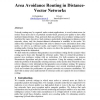Free Online Productivity Tools
i2Speak
i2Symbol
i2OCR
iTex2Img
iWeb2Print
iWeb2Shot
i2Type
iPdf2Split
iPdf2Merge
i2Bopomofo
i2Arabic
i2Style
i2Image
i2PDF
iLatex2Rtf
Sci2ools
89
Voted
INFOCOM
2008
IEEE
2008
IEEE
Area Avoidance Routing in Distance-Vector Networks
Network routing may be required, under certain applications, to avoid certain areas (or nodes) These areas can be of potential security threat, possess poor quality or have other undesired characteristics. Thus, protocols that can perform area avoidance routing can be beneficial for many objectives. Such routing is particularly challenging in distance-vector networks, where only the shortest-distance information is available to the nodes. We address this challenge by algorithms that retrieve distance-vector information from other nodes, we refer to as reference nodes, and exploit it for computing guaranteed areaavoiding paths. Having these paths, the source can direct the packets using loose source routing towards the destination. We first study the conditions that guarantee area avoidance routing for the scenario where routing can be done only through the reference nodes. Then we extend the problem to general area avoidance routing with no restrictions. For both scenarios we propose ...
Related Content
| Added | 31 May 2010 |
| Updated | 31 May 2010 |
| Type | Conference |
| Year | 2008 |
| Where | INFOCOM |
| Authors | Haim Zlatokrilov, Hanoch Levy |
Comments (0)

